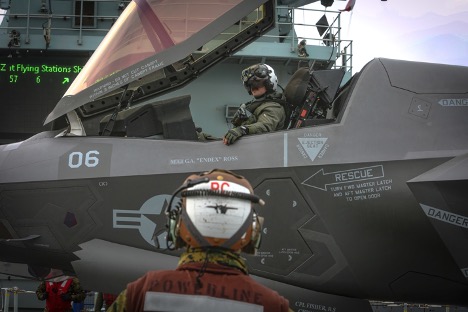VMFA-211 Commanding Officer Lt. Col. Joseph Freshour
During a recent interview with USNI News, VMFA-211 commanding officer Lt. Col. Joseph Freshour detailed how the squadrons flew combinations of aircraft, shared parts and performed integrated maintenance throughout the last few weeks.
“The jointness of the F-35 program really came to light, and the interoperability between our two units, our tactics, the digital side of how we integrate with them tactically, everything else – how we maintain the aircraft – all really went off without a real hitch, to the point that we even were able to share parts when necessary,” Freshour said. “We flew mixed elements. So in our divisions at times we had a mix of U.K. and U.S. aircraft. We had U.K. pilots leading some of our U.S. wingman and vice versa.”
For the last several weeks, the U.S. and U.K squadrons have been conducting flight operations off Queen Elizabeth during drills that allowed the two nations to test both the interoperability and the interchangeability they are striving for between navies.
“On day one, we arrived and between the two squadrons put 14 aircraft and subsequently 15 aircraft when the last jet arrived from the U.K., which is nothing like they’d ever been able to practice,” Freshour said. “So I think that’s where the biggest learning and growing took place, was pushing the flight deck and getting the flight deck prepared for what the deployment will look like in that size and scope of aircraft.”
With a total of 15 aircraft – 10 F-35Bs from VMFA-211 and five from RAF 617 – the squadrons used the recent Crimson Warrior and Group Exercise both to practice flight operations and maintenance procedures.
For example, if the U.S. squadron needed a part for its aircraft, it could temporarily use a part from the U.K. and then switch out the part for a U.S. one later on.
“What was really neat is the digital side of it. So when you switch a part from their side to our side in [Autonomic Logistics Information System], that actually was quite seamless and went really well,” Freshour said. “Because that could be a big hindrance to the execution of that – that install of that part. So that was actually a really nice point to learn, is that we were capable of doing that and it went as planned….”
Unlike American aircraft carriers, Queen Elizabeth is equipped with a ramp from which the F-35Bs can take off. Brandt and Freshour said that while the ramp necessitates slight adjustments, taking off from the British carrier was not all that different from how the Marines operate off of American amphibious ships without the ramp.
“I think it was much simpler to take off from the ramp – a little less procedures for the actual pilot in the cockpit to do,” Brandt said.
“You can take off from a shorter distance just due to the aerodynamics that the ramp is providing. There’s a little bit of a wind difference that – it has some different wind effects, just the way the wind blows around that ramp. But other than that, I don’t think there’s a whole lot of significant difference. So I think it was pretty easy to go from the LHD to the Queen Elizabeth for most of our pilots.”
Freshour, who had participated in pre-qualifications aboard the USS Essex (LHD-2) before the operations on Queen Elizabeth but was not deployed with the 13th MEU, said the aircraft has an automatic takeoff ability that can operate from the ramp on the British carrier or the flat deck of the American amphibious assault ships.
“You would start from that point on the ship lined up with the ramp and literally just take off and let the jet fly itself away,” Freshour said. “It recognizes the type of takeoff programs and the appropriate control laws and then does everything else for you.”
With a much larger deck on Queen Elizabeth compared to the Wasp-class amphibious assault ships, the Marines could fit more F-35s aboard to conduct flight operations.
Before the recent carrier operations, the Marines trained on simulators both in Yuma, Ariz., and Royal Air Force Marham. Brandt said VMFA-211 began training in the simulators at Yuma over the summer ahead of the travel to the U.K.
“Essentially for someone who’s never done it before, you’ll go through at least two normal day [carrier-landing] sims, which are an hour and a half to two hours long, two of the night sims, and then essentially EP simmer – emergency procedures simulator where we just throw jet malfunctions or aircraft malfunctions while operating at the ship,” Brandt said. “So the simulator does a really nice job of simulating the actual ship environment and then the actual feel of the aircraft. So I think every pilot would attest that they felt pretty prepared for the first time they actually flew the aircraft on.”
For the reset of the interview, see the following:
Marine F-35 Squadron Details Training Deployment Aboard HMS Queen Elizabeth

